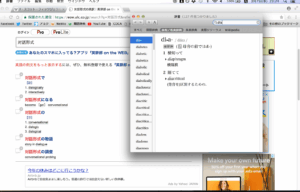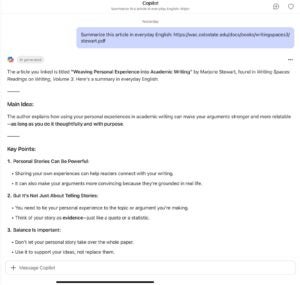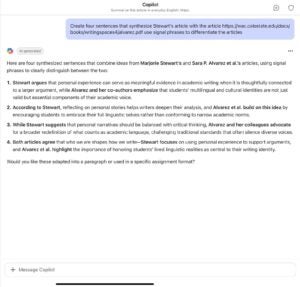Chapter 2: Reading in Writing Class
2.6 Tools in Reading Workflows
Julie A. Townsend
You have looked over your assignment sheet and know what you need to do with academic articles you’ve found. You have downloaded and saved your articles. You have your desktop space(s) arranged how you want them. You have a place to take notes and/or are ready to annotate directly on your PDF. You are already exerting command and agency over your reading workflow.
After you have planned the initial stages of your reading workflow, consider additional tools in your reading workflow.
Dictionaries and Thesauruses
Regardless of your experience with English, academic jargon can require extra work to understand. If you don’t know what a word means, look it up in a dictionary and/or thesaurus. There are many online dictionary/thesaurus websites to explore.
If you use English as an additional language, you might consider using a bilingual dictionary. For instance, Akari, a commanding bilingual in English and Japanese, often used the MacOS Dictionary to quickly access English-Japanese and English thesaurus entries while doing academic reading and writing for her Ph.D. classwork (Townsend, 2025). Use the resources available to you, in the languages you choose.

Figure 1. An example of Akari’s workflow that used two bilingual dictionaries.
AI for Pre-Reading Guidance
Think about what questions you have about your topic or the article you are planning to read. Are you looking for a summary in everyday English? Are you looking to see how the article offers guidance on a specific issue? Be as specific as possible with the AI to get the information that you need. (However, always be sure to check with your professor about AI usage and/or review AI policies in your syllabus).

Figure 2. In the Copilot chat, I used a link to the article and asked for a summary in everyday English. The response accurately summarized important parts of Stewart’s article.
AI to check for understanding
Ask AI to evaluate your summary, synthesis, and/or arguments that use the source that you have written.

Figure 3. Copilot chat that asked about synthesis and Stewart’s article.
Compare your synthesis with AI output. What is strong about your synthesis? What is strong about the AI synthesis?
AI Hallucination
While AI can be a powerful tool, you need to keep in mind what it is doing. It’s making predictions about what’s the most likely next word. It’s not a fact checker (Lingard, 2023). Always make sure that the AI is using the correct article. Alway read and understand the article on your own because AI can make mistakes.
Gaining Permission to Use AI
Again, it is important to review your course syllabus, specifically the AI Policy. If there is no policy, or if you are confused, be sure to reach out to your instructor and gain clarity about the AI policy in the class. Also, be sure to use AI ethically and with integrity – for instance, do not submit something that was generated by AI and call it your own.
Shaping the AI responses
Give the AI as much information as possible. Give it a link to the reading or upload the PDF directly. Ask it a question that you know about the reading to ensure it’s using the right source.
It takes time to read, so think about how you can make your reading time enjoyable and work with your existing responsibilities. Explore campus for your ideal reading location. Is it outside? Quiet? Loud? Do you like to listen to music while reading? You can also try out PDF readers that create audio versions for you to listen to. Your ideal reading spot could be the most important part of your reading workflow. When you take control of your reading workflow, you take control of your reading.
Discussion
- Do you use a dictionary while reading? Why and what kind of dictionaries?
- How have you taken notes on readings in the past? What did you like and/or dislike about each method?
- Is it ethical to use AI to enhance your reading? Make a list of ethical ways to use AI while reading. Make a list of unethical ways to use AI while reading. Based on these lists, make a class policy for using AI in your reading workflow.
References
Alvarez, S. P., Wan, A. J., & Lee, E. (2022). Workin’Languages: Who We Are Matters in Our Writing. writingspaces, Volume 4.
Lingard, L. (2023). Writing with ChatGPT: An illustration of its capacity, limitations & implications for academic writers. Perspectives on medical education, 12(1), 261.
Stewart, M. (2020). 11 Weaving Personal Experience into Academic Writing. writingspaces, Volume 3.
Townsend, J. (2025). Kuroko workflows: Process over product in translingual reading and writing. Journal of English for Academic Purposes, 76, 101536.

